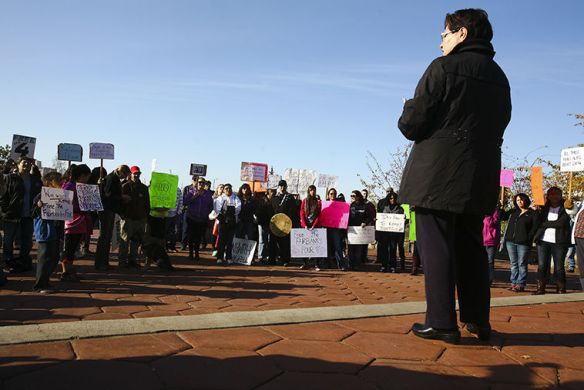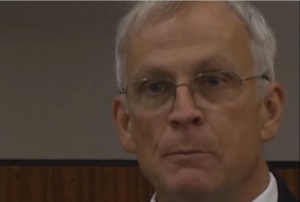The end of proceedings in the evidentiary hearing for post conviction relief is not the end of the road for the Fairbanks Four case. But it is the end of a significant portion of a long legal process, and the right day to look back on the long stretch of road already traveled and remember those who blazed the trail, who cleared the way, who walked the darkest and scariest parts, who joined in when it was the loneliest, and made the journey against all odds.
The judge could exonerate and free these men. The judge could order a new trial. The judge could uphold the convictions. Meeting the standard of clear and convincing evidence is one of the most complex and difficult legal feats in the field, and the judge could determine that it was not met. That is possible. Whatever the judge decides, it could be tomorrow, or it could be in six months. And the first thing we will have to say on that day, and the only thing we want to say today, is thank you.
Thank you to Shirley Demientieff, who stood up for the innocence of four young no-name boys when it was a position that invited scorn and ridicule. Thank you to a woman who would hold a one-person protest. Thank you to Shirley Dementieff who, on her death bed, made a request to another woman she trusted absolutely with the difficult task – please keep fighting this fight for me when I am gone.
 Thank you to Shirley Lee. The late Shirley Demientieff was right when she looked at you and saw the rare strength and bravery it would take. Thank you for keeping your promises. Thank you for picking up that sign and continuing to fight.
Thank you to Shirley Lee. The late Shirley Demientieff was right when she looked at you and saw the rare strength and bravery it would take. Thank you for keeping your promises. Thank you for picking up that sign and continuing to fight.
Thank you to the people of Evansville/ Bettles, who do not let one of your own stand alone like a crazy person with a sign. Thank you for standing behind Shirley the very moment she got up. Thank you for always believing in each other. Those of us lucky enough to know we never stand alone are lucky indeed.
Thank you to Father Scott, Saint Matthew’s Episcopal church, and the Episcopal Diocese for remembering the moral of the story, not just the words.
Thank you to the mothers. Thank you Hazel Roberts, Carol Pease, Ida Vent, Veronica Frese, Mona Nollner. Mothers never stop fighting for their children. It is never too long, they are never too tired, and the way that mothers love their children is one of the most beautiful things in the world. And thank you for fighting for Kevin like he was your own son when Carol Pease was called away from this life.
 Thank you to the people who were brave enough to stand up and demand to be heard. Who risked their jobs, reputations, took time from their families, money from their pockets, risked their businesses, risked their safety, and stood up for the truth in a climate of deceit without regard to the cost or reward Thank you Misty Nickoli, Edgar Henry, Ricko DeWilde, Annette McCotter, Skye Malemute, Jody Hassel, Bryan Duszynski. There is something to be said for people who will do the right thing when it is hard and unpopular. For people who will stand there until they are seen or speak up until they are heard. Without you nothing changes.
Thank you to the people who were brave enough to stand up and demand to be heard. Who risked their jobs, reputations, took time from their families, money from their pockets, risked their businesses, risked their safety, and stood up for the truth in a climate of deceit without regard to the cost or reward Thank you Misty Nickoli, Edgar Henry, Ricko DeWilde, Annette McCotter, Skye Malemute, Jody Hassel, Bryan Duszynski. There is something to be said for people who will do the right thing when it is hard and unpopular. For people who will stand there until they are seen or speak up until they are heard. Without you nothing changes.
 Thank you Bill Oberly of the Alaska Innocence Project. I am not sure we could find the right words to express the gratitude we feel toward you. When we reach the end of this journey, this specific journey toward justice and the end of our personal journeys, your decision to step forward and advocate for the forgotten innocent will be one of the most memorable moments we have ever encountered. It is one thing to fight for a brother, son, or friend. It is another thing entirely to take up the plight of strangers. It was your voice and yours alone inside the legal community that cried out for justice, and it was your voice that others joined.
Thank you Bill Oberly of the Alaska Innocence Project. I am not sure we could find the right words to express the gratitude we feel toward you. When we reach the end of this journey, this specific journey toward justice and the end of our personal journeys, your decision to step forward and advocate for the forgotten innocent will be one of the most memorable moments we have ever encountered. It is one thing to fight for a brother, son, or friend. It is another thing entirely to take up the plight of strangers. It was your voice and yours alone inside the legal community that cried out for justice, and it was your voice that others joined.
To the entire legal team from Dorsey and Whitney – Bob Bundy, Kate Demarest, Jahna Lindemuth, Mike Grisham, and Office of Public Advocacy attorneys Whitney Glover and Rick Allen, thank you. You put on an extraordinarily passionate, articulate, painstakingly organized, well-executed case. Imagine if you can what it feels like to watch people with power take what they want, in this case human lives, people’s children. Imagine how utterly abandoned and betrayed so many people, most of them kids, felt in 1997. Like they were invisible. Like a bad dream when you scream and scream but no one can hear you. And then you saw them, you heard them, and you rose up against a injustice that long seemed insurmountable, and you prevailed. And that is an important word, because you need to know that we already believe you won.
Thank you Bill Holmes. We hope you can find redemption for the many bad things you have done, and we are grateful that you told the truth. We hope it is the first step of many toward a more righteous life.
Thank you Scott Davison. Your bravery is humbling, your honesty against the odds is admirable.
Thank you Matt Ellsworth. We were really rooting for you to speak the truth, and are glad you did.
Thank you Tom Bole. You followed a higher code than any technicality of man.
Thank you Lisa Smith and Angie Black. We know how much work the paralegals do!
Thank you Troopers Gallen and McPherron. You served and protected the people of Alaska in the courtroom with your loyalty to justice and the truth.
Thank you to everyone who spoke up and told the truth.
Thank you Aaron ring, Jeff O’Bryant, Adrienne Bachman, Jason Gazewood, Jim Geier, and Jason Wallace. Your actions against justice have reminded us how truly valuable it is, and have inspired many to fight for it.
The courtroom at 101 Lacey Street in Fairbanks, Alaska is only a building. Stone and wood, metal and mortar, built by people, and only as permanent as its makers, which isn’t very. Sometimes there is no justice in a court of man. We cannot know what the decision of the court will be, we can only know that there is a higher order to the universe, and that the words and decisions that come from that building are ever the words and decisions of mortal men. Justice prevails in the end, and our job is simply to do our best and understand that it will come in its time.
For today we will not dwell on the past or the future, but will celebrate the day and those who brought it about. Today, parties rested their case in the first petition for post-conviction relief based on actual innocence to result in a evidentiary hearing in Alaska’s history. That is progress, and above all else, we are thankful to those who brought it about.

















